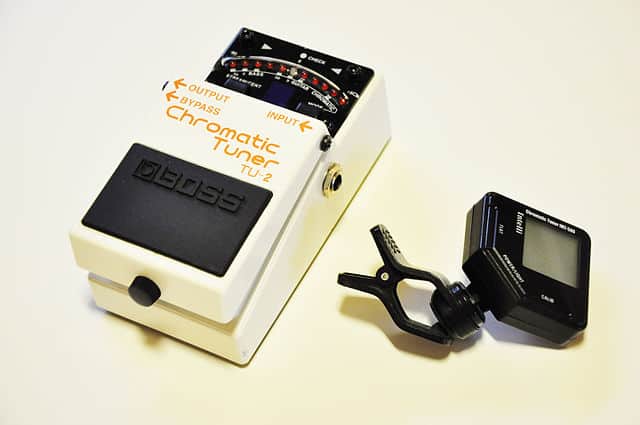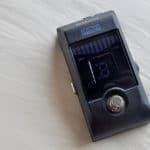Guitars create beautiful sounds. Unless, of course, they are out of tune.
Unfortunately, a guitar needs to be tuned regularly. Otherwise, it is better not to play with it at all.
So, if tuning a guitar is a must, then better to do it properly.
The best form, if not by ear, it is by using a guitar tuner.
Now, some people question the guitar tuner’s efficiency. After all, could they be wrong?
Guitar tuners are always wrong, but they are still efficient for our human ears. More precisely, the tuning is never at the exact pitch of the note, but this is not a problem because the difference is too minimal for us to perceive it.
This topic seems hard to grasp, but I assure you it is simpler than it looks.
Let’s dive into it and understand more about this fantastic tool.
How do guitar tuners work?
Guitar tuners measure the string’s frequency, showing the current tuning of the string.
Tuners take a signal, whether it is through a microphone, sensor, or cable, and then amplify and digitalize that signal.
However, the sound waves of the signal change gradually, so the tuner analyzes and calculates the most approximate result.
Let’s check this explanation thoroughly and in a more detailed form.
First, consider that sound is an array of vibrations. The sound waves that the vibration itself creates travel through the air, interacting with air molecules and resonating with the objects they reach.
The height of these sound waves defines frequency, amplitude, and pitch.
Now, the tuner detects a signal, detects its pitch, and calculates its frequency. Then, it converts the information to a current pitch, showing it on the tuner’s monitor.
From there, the guitarist either lowers or raises the pitch until reaching the correct note.
Most tuners work with one string at a time. However, there is a type of tuner called “polyphonic” which measures all the string frequencies simultaneously.
Nonetheless, most tuners work note-by-note.
Can guitar tuners be wrong?
Generally, guitar tuners work perfectly.
However, they don’t provide an accurate pitch. They just reach the closest to the desired outcome.
Needless to say, this difference is almost unnoticeable, so you won’t find unbearable issues when playing.
Also, depending on the tuners, some will be more accurate than others.
The most precise tuners (strobe tuners) reach 0.1 cents from the wanted tune (the cent is used to measure the smaller increments in pitch). So, it is almost the exact tune!
Compare them to other digital tuners, which reach within 1 and 2 cents from the right pitch.
To sum up, a guitar tuner is always “wrong”, but for the way we perceive sound, they are alright.
What could make a guitar tuner not work properly?
There are certain things to check if you discover the tuner is not working properly.
First of all, try resetting it. Sometimes this simple task is more than enough to solve the malfunction.
If this doesn’t work, then it is probably a battery-related issue. See if you can replace the battery for one that is not dying out (or that it hasn’t done it yet).
Also, the tuner could be picking up a lot of ambient noise and not distinguishing it from your guitar.
Lastly, you may even get the tuner repaired or even buy a new one.
But remember, there are tuning apps for free, so you might consider those before purchasing a brand new physical one.
Should you always trust your guitar tuner?
All in all, a guitar tuner is a reliable tool.
After all, despite not being 100 percent accurate, they get so close that the difference passes unnoticed.
Unless you are superhuman, you won’t notice dissimilarities.
Nonetheless, you should not trust your tuners when you are aware it is not working right (check the paragraph above for more information on it).
How to know if your guitar tuner is working properly?
Now, what if you are unsure whether the tuner is working correctly or not?
Well, the first clear sign will be noticing that your guitar doesn’t sound good at all.
Try playing a couple of chords once you end up tuning. If you notice there’s something off, then that’s a clear sign that the tuner didn’t work.
Also, if the tuner has a screen, it is most likely that the screen will not function the right way, especially if the battery is drying out.
Lastly, you may compare your tuner with an online tuner, (or a tuning Youtube video) and see if the sound of your guitar matches the tuning pitch of the other tuner.
Alternatives to a guitar tuner
There is a great deal of tuning alternatives to try.
First, start developing the habit of tuning by ear.
I know that for some it is a tough ask, and to be honest, it is.
However, the more you practice it, the sooner you’ll be able to tune the guitar by ear. At least, you may approximate really close.
This ability is very useful since there are certain occasions on which you won’t have a tuner at hand.
Also, you may use a tuning fork, although these are a bit harder than tuning by ear. However, if you know how to use it, you’ll get better results than tuning by ear.
Lastly, use a Youtube video as a guide. There are videos that serve as a tuning reference.
For example, the video takes the sound of the sixth string in E standard. So, you may wrap the tuning pegs until the guitar’s note and the video’s note coincide.
A guitar tuner is a great tool, but getting used to tuning by ear, not only will sharpen your hearing abilities, but it will make you a better musician.

Hello there, my name is Ramiro and I’ve been playing guitar for almost 20 years. I’m obsessed with everything gear-related and I thought it might be worth sharing it. From guitars, pedals, amps, and synths to studio gear and production tips, I hope you find what I post here useful, and I’ll try my best to keep it entertaining also.





